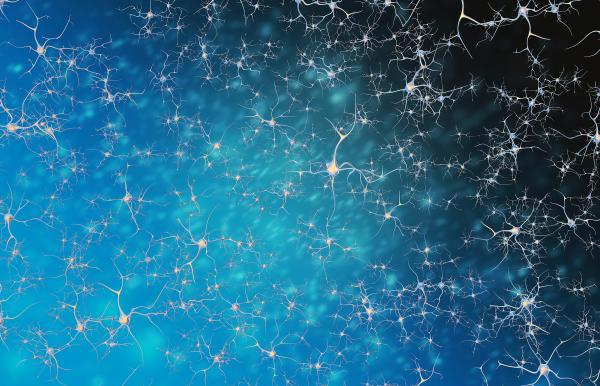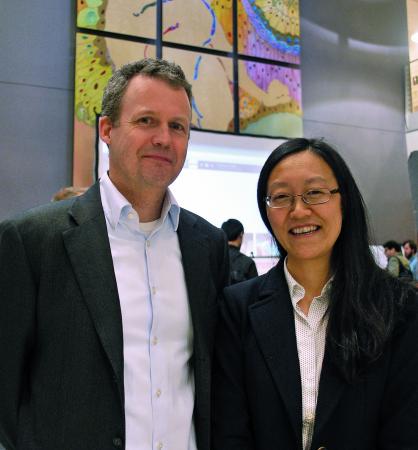Imagine trying to eavesdrop on the human brain, with its complex, chattering galaxy of 86 billion neurons, each one connected to thousands of other neurons, holding cellular conversations through more than 100 trillion synaptic connections.
It is a dense and noisy communication network, wrapped and hidden deep within precious tissue. We’ve pondered over, poked, and prodded the brain for centuries. But so much of what goes on inside our skulls is a mystery and neuro-research is still closer to the starting line than the finish.
At the Georgia Institute of Technology, scientists and engineers from different backgrounds have formed an interdisciplinary research community called ‘GTNeuro.’ They’re out to improve our understanding of the brain and the entire nervous system, and they’re seeking and creating the means to treat neurological diseases and injuries, even boost neural function, bringing the mysteries of the human brain into clearer focus.
“There’s a large and growing community here, of people focused on basic science, translation, and technology related to a range of neurological diseases and disorders, and all of this is bolstered by a vibrant educational and training environment,” says Garrett Stanley, a researcher in the Petit Institute for Bioengineering and Bioscience and professor in the Wallace H. Coulter Department of Biomedical Engineering (BME, a joint department of Emory and Georgia Tech).
Busy Intersection
Currently, there are more than 60 faculty researchers from Georgia Tech and Emory under the GTNeuro umbrella, and they come from the schools of Biological Sciences, Chemical and Biomolecular Engineering, Mechanical Engineering, Electrical & Computer Engineering (ECE), Psychology, and Physics at Georgia Tech, in addition to BME and multiple departments and divisions at Emory.
“The activities at Georgia Tech represent an intersection of basic neuroscience, and engineering-driven neuro-technology, a synergy which is necessary to drive the field forward,” says Stanley, who co-chairs the faculty steering committee for GTNeuro (with Petit Institute researcher Todd Streelman, professor and chair in the School of Biological Sciences).
“GTNeuro is just a very organic, faculty-driven kind of thing,” says Stanley, who also co-chairs the Neural Engineering Center (one of the research centers based at the Petit Institute, which also houses the Neuro Design Suite, a core lab facility) with Lena Ting, a professor who joined the Coulter Department 15 years ago.
“We were a small but tightly integrated group in the Laboratory for Neuroengineering, which occupied the third floor of the Whikater Building,” says Ting.
The small neuro-community of six neuro-researchers (two ECE faculty members, and four from BME) included, in addition to Ting, current Petit Institute researchers Rob Butera and Michelle LaPlaca.
“We pooled resources and had an internal seminar series, shared a lab manager. It was a very tight knit community,” says Ting. “Back then, we were about the only neuroscience research on the Georgia Tech campus. Slowly, over the last 12 years or so, that has changed dramatically.”
The burgeoning interest in neuro-research (across disciplines and department boundaries) was exemplified recently in the 25th edition of the Suddath Symposium at the Petit Institute (Feb. 21-22). The focus was neuroscience. Thought leaders from across the country and overseas spent two days discussing their research at the symposium, where the theme was “Neuromodulation and Synaptic Control: Modern Tools and Applications.”
Accelerating Progress
Every Monday in the Engineered Biosystems Building (EBB), a packed room takes in the GTNeuro Seminar Series, in which a wide range of experts – from Georgia Tech, Emory, and beyond – present cutting edge research.
These popular seminars, which start at 11 a.m. in EBB Room 1005, are video-conferenced to Emory, and recorded (and made available through the Georgia Tech Library).
Recent speakers have come from Case Western, Princeton, Harvard, in addition to brain experts from right here. Most recently, Audrey Duarte from Georgia Tech’s School of Psychology presented a talk entitled, “What can neuroimaging tell us about age-related memory changes?” In two weeks, Mark Frye from UCLA will discuss how flies see the world. And later in March, Machelle Pardue of the Coulter Department will talk about how to improve detection and treatment of diabetic retinopathy.
“We’re attracting 80, 100 people on a weekly basis,” says Ting, who is based at Emory, where she now heads up the Neuromechanics Lab. “That really suggests that no matter what kind of topic we’re presenting, and it’s been diverse, people are hungry to learn about neuroscience.”
Modern neuroscience is about a century old, but research has really hastened over the past 20 years, mostly due to the development of new tools and technology, according to Stanley.
“Neuroscience has always pivoted around advances in techniques and technologies that enable us to better measure and manipulate different aspects of the networks of the tens of billions of neurons in the brain and the rest of the nervous system," he says.
Also, federal government support through programs like the BRAIN (Brain Research through Advancing Innovative Neurotechnologies) Initiative are helping to drive research, “accelerating our understanding of both normal brain function, and function related to a range of neurological disorders,” says Stanley, whose own research is all about making sense of what all of those neurons are saying to each other.
Exploring the Network
The researchers who form GTNeuro are approaching the problem of understanding the brain and the nervous system from many directions with a diverse toolbox.
Ting’s work, for example, draws from neuroscience, biomechanics, rehabilitation, robotics, and physiology, which has led to discoveries of new principles of human movement. Her research is used by other researchers across the planet, to understand both normal and impaired movement control in humans and animals, and to develop better robotic devices.
Meanwhile, the lab of Petit Institute researcher Craig Forest is perfecting a robotic cleaning technique to automate and improve neuroscience research, and looking for ways to record what’s happening deep inside the brain.
“Our mission is to develop the tools that make new science possible,” says Forest, associate professor in the Woodruff School of Mechanical Engineering.
His lab developed a technique that will allow the pipettes used in patch-clamping to be reused over and over again. Patch-camping, the method used to stimulate and record neuron activity, involves touching the cell membrane with a glass pipette – a painstaking, prolonged process, and these pipettes are typically used only once.
The new cleaning process, integrated with the Autopatcher (robotic patch-clamping technology from the Forest lab), saves money on pipettes while gathering more data, faster.
The lab of Hang Lu, Petit Institute researcher and professor in the School of Chemical and Biomolecular Engineering, also is in the business of gathering large-scale data, through engineering BioMEMS (Bio Miro-Electro-Mechanical Systems) and microfluidic devices. These ‘Lab-on-a-chip’ tools are used to study how the nervous system develops and functions, and how genes and environment influence behavior.
“We’re a little different in terms of the space we occupy in neuro-research on campus,” says Lu, who was co-director with Stanley of the neuro-focused Suddath Symposium. “Functional researchers like Garrett or Rob Butera are very much down to the neurons and circuits. My lab’s approach is complementary.”
Butera (who holds a joint appointment in BME and ECE) and his lab colleagues have developed an implanted device that stimulates the vagus nerve to treat chronic inflammation, while also targeting and inhibiting unwanted nerve activity.
High Aspirations
Butera was principal investigator of the vagus nerve study, but the lead researcher was grad student Yogi Patel, who represents the next generation of neuroengineering.
“We’re actually working with a clinician at Emory to try and push this into some human evaluation,” says Patel, a fifth-year Ph.D. student. “That’s the key thing, to get this approved so it can be used in patients. It’s very promising.”
So is his future in neuroscience research. He already has a postdoctoral position lined up at Johns Hopkins University.
“It’s a fundamental neuroscience lab, more science than engineering,” says Patel, who is also serving as a consultant to industry on the side. “Long term, I still want to have my own research lab one day.”
It’s an aspiration that became a reality for Annabelle Singer less than a year ago, when she joined the Coulter Department at Georgia Tech and Emory, where her lab is exploring how neural activity guides behavior in health and disease. She was a lead author of recently published research demonstrating a non-invasive, flickering light treatment that reduces the build-up of plaques closely associated with Alzheimer’s disease.
This radically different approach has lots of promise, she says, but like so much else in a relatively nascent field like neuroscience, there are flights of steps to go before it can be translated into therapeutics for humans. Singer believes she’s in the right place to take those steps.
“There’s a culture of collaboration here, a kind of unity of purpose,” says Singer, who also recently joined the Petit Institute. “That was a big appeal for me.”
So was Emory’s Alzheimer’s Disease Research Center, and the Neuro Design Suite at the Petit institute, and the complementary research of colleagues who are all trying to make better sense of the brain, like Stanley, who wants to read and write the neural code.
“Patterns of activity in the brain are a language of sorts, but a language we don’t yet understand,” he says.
It only weighs about 3.3 pounds, but the human brain is still mostly unexplored or virtually inaccessible. Stanley and his GTNeuro colleagues are out there, making their way and charting new paths in a gray matter frontier.
“How cells interact within the complex networks in our brain and nervous system underlies many diseases and disorders,” Stanley says. “The advent of new tools for dissecting circuits within the nervous system gives us, for the first time, the ability to actually ‘see’ and interact with the networks in a very specific and precise manner, perhaps leading to new insights and discoveries for treating a range of neurological disorders and diseases.”
LINKS:
Center for Advanced Brain Imaging
CONTACT:
Jerry Grillo
Communications Officer II
Parker H. Petit Institute for
Bioengineering and Bioscience
Media Contact
Jerry Grillo
Communications Officer II
Parker H. Petit Institute for
Bioengineering and Bioscience
Keywords
Latest BME News
Jo honored for his impact on science and mentorship
The department rises to the top in biomedical engineering programs for undergraduate education.
Commercialization program in Coulter BME announces project teams who will receive support to get their research to market.
Courses in the Wallace H. Coulter Department of Biomedical Engineering are being reformatted to incorporate AI and machine learning so students are prepared for a data-driven biotech sector.
Influenced by her mother's journey in engineering, Sriya Surapaneni hopes to inspire other young women in the field.
Coulter BME Professor Earns Tenure, Eyes Future of Innovation in Health and Medicine
The grant will fund the development of cutting-edge technology that could detect colorectal cancer through a simple breath test
The surgical support device landed Coulter BME its 4th consecutive win for the College of Engineering competition.










